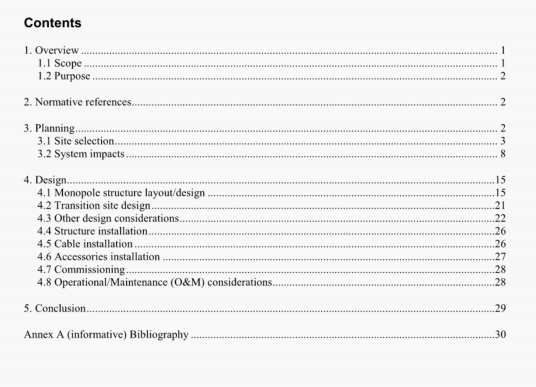IEEE 1793:2012 pdf free download.IEEE Guide for Planning and Designing Transition Facilities
between Overhead and Underground Transmission Lines.
— Topography; A flat area is needed around the structure to allow for mitial installation and future maintenance. The size of thc required flat arca is determined by the ultimatc configuration of the transition site. If a flat area is unavailable, the area will generally need to be graded to provide a suitable area. Retaining walls or other slope stabilization methods may be necessary to suppoil any cuts in side-slope areas.
— Geological impacts: The soil should be evaluated for suitability for installation of roads and foundations. Frequently, the termination structure for the overhead line has the most significant foundation requirements, so this structure should be evaluated against local soil conditions Unsuitable soils may trigger additional civil construction requirements Ipiles. larger foundations. cutstiUs, cic). To the extent possible, areas with waler issues I wetlands, marshes, flood plain. etc.) should be avoided for both environmental and consttuction reasons. Areas designated as high seismic zones would require specialized engineering and construction techniques, and should be avoided to the extent possible.
— Airborne contaminant impacts: The transition station may be located in an area subject to airborne contamination. Examples include salt spray from either coastal locations or from roadway deicing treatments, airborne dust, pollution from industrial processes, or other contaminants. Consideration of higher voltage class insulation for the open air cofloncnts of the transition, and consideration of higher voltage class cable terminations may be necessary.
— Land usc; L)cpcnding on the type of transition facility imonopolc transition structures or a transition station), the land use requirements will be different. In the case of individual monopole risers, the transition will typically be done within the same overall width as the balance of the overhead right of way.
A transition station equipped with multiple cables per phase, shunt reactors, switching equipment, a control house and possibly pressurizing equipment (for pipe-type cables) will require significant space. A transition station might occupy a hectare or more (several acres) of land.
l.and usc issues often fall undcr local zoning regulations. The proponent of a transition station site might have to demonstrate consistency with toning requirements or obtain variances.
— Access; Regardless of whether a monopoic structure or a transition station is required, underground lines need to be constructed in areas that have access for trucks, trailers, and the other equipment used to install conduits andor pipe. set manholes, lay or pull cable, and install accessories. Unrestricted access to the transition site is essential both for initial construction, and for ongoing operation and maintenance. For monopole structures, the access should be such to allow maintenance vehicles to drive up to the pole to fuetlitate initial construction, operation, and maintenance of the structure and cable system. Whether a monopolc or a transition station, the site should be sized to appropriately acconunodale the installation and maintenance equipment needed 1kw the particular cable system Access is frequently a significant factor in determining the overall space requirement at the transition. Site access will typically require construction of access roads at suitable grades for the passagc of construction vehicles. Within a fenced transition station. sufficient room should be created within the fence to allow cable reels and reel handling equipment to get to the c.ihlc pulling location, both 1kw the initial installation and any possible hiture repairs. If shunt reactors arc required. the transition station needs to be located where very large trucks can access the site to deliver and replace the reactors in the event of a failure.
IEEE 1793:2012 pdf free download
